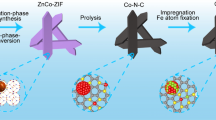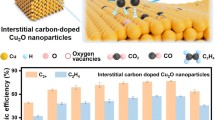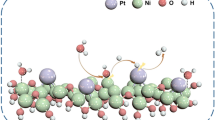Abstract
Selective transfer hydrogenation of nitroarenes to amines with transition metal nanocatalysts is appealing due to its low-cost, moderate reaction conditions, good activity and excellent selectivity. Single-atom catalysts (SACs) possessing advantages of maximum atom efficiency and particular electronic structure are expected to be more effective for this reaction, yet no report about it. Herein, cobalt single atoms anchored on N-doped ultrathin carbon nanosheets (denoted as CoSAs/NCNS) were produced and demonstrated as an outstanding SAC for selective transfer hydrogenation of nitroarenes to amines with formic acid as hydrogen donor. The turnover frequency (TOF) reached 110.6 h−1, which was 20 times higher than the best results of cobalt nanoparticles reported in literatures under similar reaction conditions. Moreover, CoSAs/NCNS exhibited excellent selectivity for a variety of nitroarenes bearing other reducible functionalities, such as iodo, cyano, keto, vinyl, alkynyl and ester groups. The findings further highlight the ability and advantages of SACs in heterogeneous catalysis.
摘要
过渡金属催化芳香硝基化合物氢转移反应制备胺类化合物, 具有成本低廉、 反应条件温和、 高活性、 高选择性等优点. 单原子催化剂具有最大的原子利用率和独特的电子结构, 有望进一步提升其催化反应性能, 但目前还没有关于单原子催化剂应用于该反应的文献报道. 本文制备了负载于氮掺杂超薄碳纳米片上的钴单原子催化剂(简写为CoSAs/NCNS), 并将其应用于芳香硝基化合物氢转移反应中, 在与文献报道类似的反应条件下, 该催化剂的 TOF达110.6 h−1, 是已报道结果的20倍; 且该催化剂对一系列具有其他不饱和官能团(如: 卤素, 氰基, 醛基, 乙烯基和乙炔基等)的硝基化合物具有优异的选择性.
Similar content being viewed by others
References
Qiao B, Wang A, Yang X, et al. Single-atom catalysis of CO oxidation using Pt1/FeOx. Nat Chem, 2011, 3: 634–641
Yang XF, Wang A, Qiao B, et al. Single-atom catalysts: A new frontier in heterogeneous catalysis. Acc Chem Res, 2013, 46: 1740–1748
Bayatsarmadi B, Zheng Y, Vasileff A, et al. Recent advances in atomic metal do** of carbon-based nanomaterials for energy conversion. Small, 2017, 13: 1700191
Cui X, Li W, Ryabchuk P, et al. Bridging homogeneous and heterogeneous catalysis by heterogeneous single-metal-site catalysts. Nat Catal, 2018, 1: 385–397
Liu L, Corma A. Metal catalysts for heterogeneous catalysis: From single atoms to nanoclusters and nanoparticles. Chem Rev, 2018, 118: 4981–5079
Zhang H, Liu G, Shi L, et al. Single-atom catalysts: Emerging multifunctional materials in heterogeneous catalysis. Adv Energy Mater, 2018, 8: 1701343
Yan H, Su C, He J, et al. Single-atom catalysts and their applications in organic chemistry. J Mater Chem A, 2018, 6: 8793–8814
Kyriakou G, Boucher MB, Jewell AD, et al. Isolated metal atom geometries as a strategy for selective heterogeneous hydrogenations. Science, 2012, 335: 1209–1212
Guo X, Fang G, Li G, et al. Direct, nonoxidative conversion of methane to ethylene, aromatics, and hydrogen. Science, 2014, 344: 616–619
Grundner S, Markovits MAC, Li G, et al. Single-site trinuclear copper oxygen clusters in mordenite for selective conversion of methane to methanol. Nat Commun, 2015, 6: 7546
Wang L, Guan E, Zhang J, et al. Single-site catalyst promoters accelerate metal-catalyzed nitroarene hydrogenation. Nat Commun, 2018, 9: 1362
Jones J, **. Science, 2016, 353: 150–154
Liu P, Zhao Y, Qin R, et al. Photochemical route for synthesizing atomically dispersed palladium catalysts. Science, 2016, 352: 797–800
Chen Y, Ji S, Sun W, et al. Discovering partially charged single-atom Pt for enhanced anti-markovnikov alkene hydrosilylation. J Am Chem Soc, 2018, 140: 7407–7410
Liu G, Robertson AW, Li MMJ, et al. MoS2 monolayer catalyst doped with isolated Co atoms for the hydrodeoxygenation reaction. Nat Chem, 2017, 9: 810–816
Lin L, Zhou W, Gao R, et al. Low-temperature hydrogen production from water and methanol using Pt/α-MoC catalysts. Nature, 2017, 544: 80–83
Fang X, Shang Q, Wang Y, et al. Single Pt atoms confined into a metal-organic framework for efficient photocatalysis. Adv Mater, 2018, 30: 1705112
Marcinkowski MD, Darby MT, Liu J, et al. Pt/Cu single-atom alloys as coke-resistant catalysts for efficient C-H activation. Nat Chem, 2018, 10: 325–332
Tang Y, Li Y, Fung V, et al. Single rhodium atoms anchored in micropores for efficient transformation of methane under mild conditions. Nat Commun, 2018, 9: 1231
Chen Y, Li Z, Zhu Y, et al. Atomic Fe dispersed on N-doped carbon hollow nanospheres for high-efficiency electrocatalytic oxygen reduction. Adv Mater, 2019, 31: 1806312
Liu J. Catalysis by supported single metal atoms. ACS Catal, 2016, 7: 34–59
Giannakakis G, Flytzani-Stephanopoulos M, Sykes ECH. Singleatom alloys as a reductionist approach to the rational design of heterogeneous catalysts. Acc Chem Res, 2019, 52: 237–247
Liang Z, Qu C, **a D, et al. Atomically dispersed metal sites in MOF-based materials for electrocatalytic and photocatalytic energy conversion. Angew Chem Int Ed, 2018, 57: 9604–9633
Lin R, Albani D, Fako E, et al. Design of single gold atoms on nitrogen-doped carbon for molecular recognition in alkyne semihydrogenation. Angew Chem Int Ed, 2019, 58: 504–509
Podyacheva OY, Bulushev DA, Suboch AN, et al. Highly stable single-atom catalyst with ionic Pd active sites supported on n-doped carbon nanotubes for formic acid decomposition. Chem-SusChem, 2018, 11: 3724–3727
Sun G, Zhao ZJ, Mu R, et al. Breaking the scaling relationship via thermally stable Pt/Cu single atom alloys for catalytic dehydrogenation. Nat Commun, 2018, 9: 4454
Li H, Wang L, Dai Y, et al. Synergetic interaction between neighbouring platinum monomers in CO2 hydrogenation. Nat Nanotech, 2018, 13: 411–417
Yan H, Lv H, Yi H, et al. Understanding the underlying mechanism of improved selectivity in Pd1 single-atom catalyzed hydrogenation reaction. J Catal, 2018, 366: 70–79
Downing RS, Kunkeler PJ, van Bekkum H. Catalytic syntheses of aromatic amines. Catal Today, 1997, 37: 121–136
Blaser HU, Steiner H, Studer M. Selective catalytic hydrogenation of functionalized nitroarenes: An update. ChemCatChem, 2009, 1: 210–221
Jagadeesh RV, Surkus AE, Junge H, et al. Nanoscale Fe2O3-based catalysts for selective hydrogenation of nitroarenes to anilines. Science, 2013, 342: 1073–1076
Westerhaus FA, Jagadeesh RV, Wienhöfer G, et al. Heterogenized cobalt oxide catalysts for nitroarene reduction by pyrolysis of molecularly defined complexes. Nat Chem, 2013, 5: 537–543
Wei Z, Wang J, Mao S, et al. In situ-generated Co0-Co3O4/N-doped carbon nanotubes hybrids as efficient and chemoselective catalysts for hydrogenation of nitroarenes. ACS Catal, 2015, 5: 4783–4789
Zhang S, Chang CR, Huang ZQ, et al. High catalytic activity and chemoselectivity of sub-nanometric Pd clusters on porous nanorods of CeO2 for hydrogenation of nitroarenes. J Am Chem Soc, 2016, 138: 2629–2637
Liu L, Concepción P, Corma A. Non-noble metal catalysts for hydrogenation: A facile method for preparing Co nanoparticles covered with thin layered carbon. J Catal, 2016, 340: 1–9
Schwob T, Kempe R. A reusable Co catalyst for the selective hydrogenation of functionalized nitroarenes and the direct synthesis of imines and benzimidazoles from nitroarenes and aldehydes. Angew Chem Int Ed, 2016, 55: 15175–15179
Sun X, Olivos-Suarez AI, Osadchii D, et al. Single cobalt sites in mesoporous N-doped carbon matrix for selective catalytic hydrogenation of nitroarenes. J Catal, 2018, 357: 20–28
Shalom M, Molinari V, Esposito D, et al. Sponge-like nickel and nickel nitride structures for catalytic applications. Adv Mater, 2014, 26: 1272–1276
Jagadeesh RV, Natte K, Junge H, et al. Nitrogen-doped graphene-activated iron-oxide-based nanocatalysts for selective transfer hydrogenation of nitroarenes. ACS Catal, 2015, 5: 1526–1529
Jagadeesh RV, Banerjee D, Arockiam PB, et al. Highly selective transfer hydrogenation of functionalised nitroarenes using cobalt-based nanocatalysts. Green Chem, 2015, 17: 898–902
Zhou P, Zhang Z. One-pot reductive amination of carbonyl compounds with nitro compounds by transfer hydrogenation over Co-Nx as catalyst. ChemSusChem, 2017, 10: 1892–1897
Duan Y, Song T, Dong X, et al. Enhanced catalytic performance of cobalt nanoparticles coated with a N, P-codoped carbon shell derived from biomass for transfer hydrogenation of functionalized nitroarenes. Green Chem, 2018, 20: 2821–2828
Xu X, Luo J, Li L, et al. Unprecedented catalytic performance in amine syntheses via Pd/g-C3N4 catalyst-assisted transfer hydrogenation. Green Chem, 2018, 20: 2038–2046
Gawande MB, Rathi AK, Branco PS, et al. Regio- and chemose-lective reduction of nitroarenes and carbonyl compounds over recyclable magnetic ferritenickel nanoparticles (Fe3O4-Ni) by using glycerol as a hydrogen source. Chem Eur J, 2012, 18: 12628–12632
Cabrero-Antonino JR, Adam R, Junge K, et al. Cobalt-catalysed transfer hydrogenation of quinolines and related heterocycles using formic acid under mild conditions. Catal Sci Technol, 2017, 7: 1981–1985
Jia WG, Ling S, Zhang HN, et al. Half-sandwich ruthenium phenolate-oxazoline complexes: Experimental and theoretical studies in catalytic transfer hydrogenation of nitroarene. Organometallics, 2018, 37: 40–47
Jagadeesh RV, Wienhöfer G, Westerhaus FA, et al. Efficient and highly selective iron-catalyzed reduction of nitroarenes. Chem Commun, 2011, 47: 10972–10974
Brieger G, Nestrick TJ. catalytic transfer hydrogenation. Chem Rev, 1974, 74: 567–580
Wang D, Astruc D. The golden age of transfer hydrogenation. Chem Rev, 2015, 115: 6621–6686
Cao Y, Chen S, Luo Q, et al. Atomic-level insight into optimizing the hydrogen evolution pathway over a Co1-N4 single-site photo-catalyst. Angew Chem Int Ed, 2017, 56: 12191–12196
Han A, Chen W, Zhang S, et al. A polymer encapsulation strategy to synthesize porous nitrogen-doped carbon-nanosphere-supported metal isolated-single-atomic-site catalysts. Adv Mater, 2018, 30: 1706508
Huang P, Huang J, Pantovich SA, et al. Selective CO2 reduction catalyzed by single cobalt sites on carbon nitride under visible-light irradiation. J Am Chem Soc, 2018, 140: 16042–16047
Pan Y, Lin R, Chen Y, et al. Design of single-atom Co-N5 catalytic site: a robust electrocatalyst for CO2 reduction with nearly 100% CO selectivity and remarkable stability. J Am Chem Soc, 2018, 140: 4218–4221
Zhu C, Shi Q, Xu BZ, et al. Hierarchically porous M-N-C (M = Co and Fe) single-atom electrocatalysts with robust MNx active moieties enable enhanced ORR performance. Adv Energy Mater, 2018, 8: 1801956
Zhang H, Wei J, Dong J, et al. Efficient visible-light-driven carbon dioxide reduction by a single-atom implanted metal-organic framework. Angew Chem Int Ed, 2016, 55: 14310–14314
Acknowledgements
The authors acknowledge the financial support from the National Key R&D Program of China (2018YFA0208504), the National Natural Science Foundation of China (21573244 and 21573245), and the Youth Innovation Promotion Association of CAS (2017049).
Author information
Authors and Affiliations
Corresponding authors
Additional information
Huining Li received her BSc degree from Hebei Normal University in 2014. Now, she is a PhD student under the supervision of Prof. Weiguo Song at the Institute of Chemistry, Chinese Academy of Sciences, China. Her research interests mainly focus on the design and fabrication of single-atom catalysts for heterogeneous catalysis.
Changyan Cao obtained his PhD degree from Harbin Institute of Technology in 2011. Since then he did postdoctoral research under the supervision of Prof. Weiguo Song at the Institute of Chemistry, Chinese Academy of Sciences. Currently, he is an associate professor in Prof. Weiguo Song’s group. His current research interest mainly focuses on the design and controllable synthesis of nanocatalysts with high-performance.
Weiguo Song obtained his BSc degree from Peking University in 1992 and his PhD degree from the University of Southern California in 2001. Now, he is a full professor in the Institute of Chemistry, Chinese Academy of Sciences. His current research interest mainly focuses on the synthesis of nanostructured materials and their applications in heavy metal ions adsorption and nanocatalysis.
Electronic supplementary material
Rights and permissions
About this article
Cite this article
Li, H., Cao, C., Liu, J. et al. Cobalt single atoms anchored on N-doped ultrathin carbon nanosheets for selective transfer hydrogenation of nitroarenes. Sci. China Mater. 62, 1306–1314 (2019). https://doi.org/10.1007/s40843-019-9426-x
Received:
Accepted:
Published:
Issue Date:
DOI: https://doi.org/10.1007/s40843-019-9426-x




